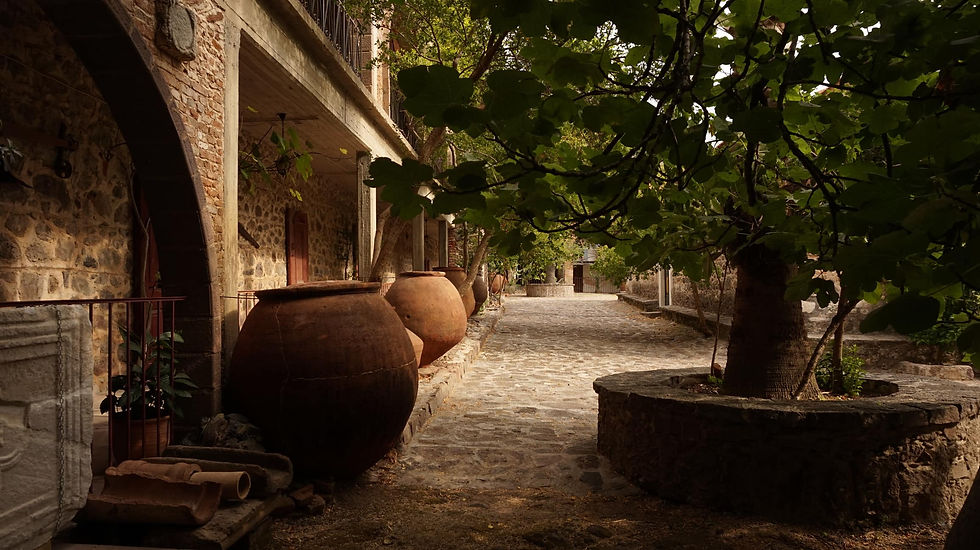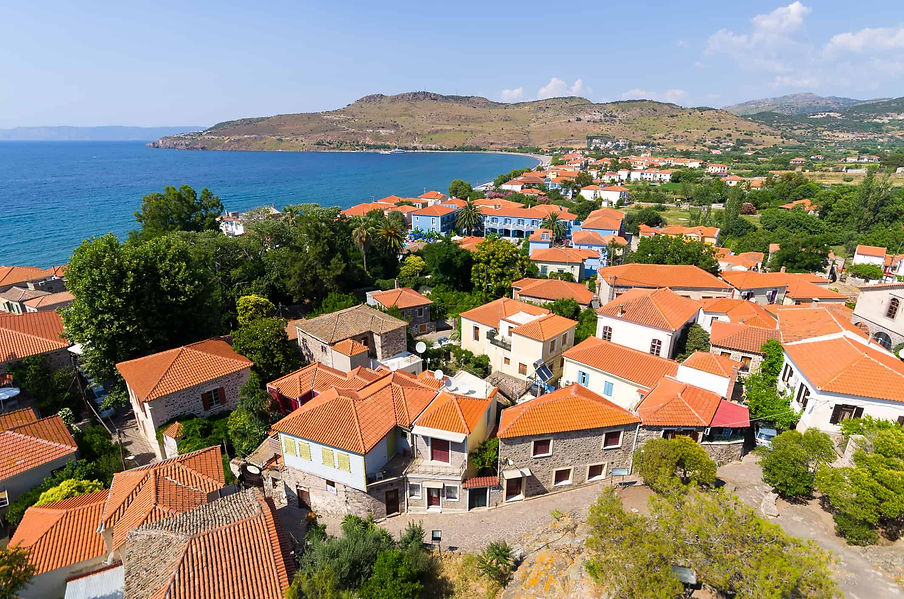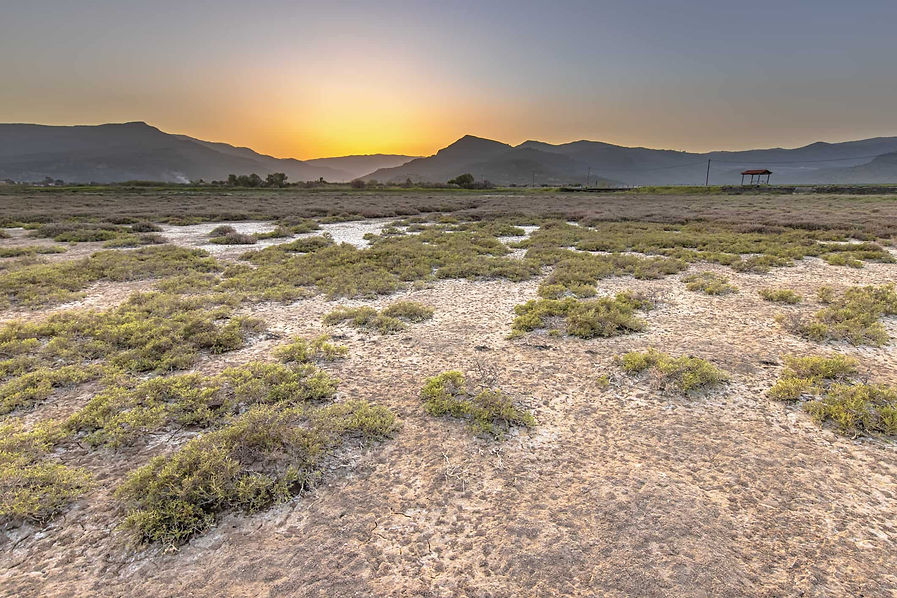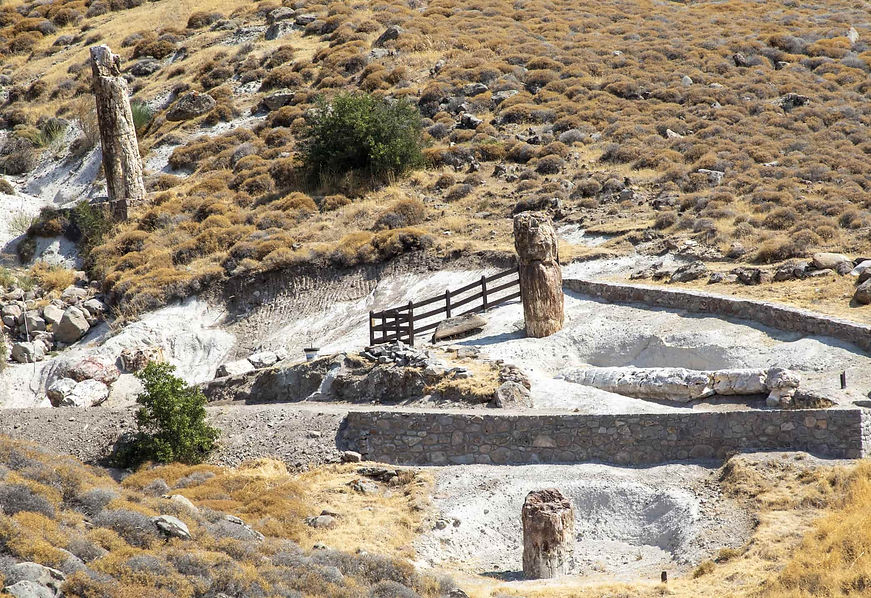Lesvos
The Island of Poetry & Art
Author
George | Shiny Greece Team (feat. ai)

Molyvos Village | Photo by: 155659800, Freesurf69, Dreamstime.com
Lesvos, the third largest island in Greece, is located in the northeastern Aegean Sea, offering a unique blend of history, culture, and natural beauty. The island is known for its impressive landscapes, rich history, and diverse ecosystems, making it one of the most intriguing destinations in Greece. As part of the North Aegean Region, Lesvos is surrounded by other significant islands, including Chios, Limnos, and Samos, each contributing to the rich mosaic of the area’s cultural and historical heritage. The island’s capital, Mytilini, is a vibrant city with a mix of ancient and modern influences, serving as the hub of life on the island.
Lesvos is famous for its remarkable landscapes, which range from lush forests to rugged mountains, as well as its unique geothermal features, including hot springs and the renowned Petrified Forest. These natural wonders contribute to the island’s recognition as a UNESCO Global Geopark. The island is also known for its incredible biodiversity, with several protected areas that are ideal for eco-tourism and nature enthusiasts. Its fertile lands are covered in olive groves - over 11 million olive trees, which represent a key aspect of the island’s economy, providing the basis for its thriving olive oil production.
The cultural heritage of Lesvos is deeply intertwined with its history as a center of ancient civilization. It was the birthplace of the poet Sappho, born in Eressos around 630 BC, whose powerful emotional poetry has made the island famous, especially in the modern LGBT community, as her work expressed deep affection and admiration for women. Sappho's legacy is one of the key reasons for Lesvos's cultural prominence, and her influence extended beyond literature to the arts, with her work shaping the island’s identity as a hub of creativity and intellectual exchange.
Visitors to the island can explore not only the legacy of Sappho but also the contributions of other historical figures such as the poet Alcaeus, the philosopher Theophrastus, and the Nobel laureate Odysseus Elytis, who was deeply inspired by the island’s landscape.
Lesvos is a crossroads of ancient civilizations, where Eastern and Western cultures merged. Its archaeological sites, including the ancient city of Pyrra and the ancient city of Mytilini, as well as its many churches and monasteries, tell the story of a land shaped by different cultures throughout history. The island’s medieval castles, charming villages, and pristine beaches add to its appeal as a destination for travelers seeking both cultural exploration and relaxation.
Moreover, Lesvos is one of the sunniest islands in the Aegean, offering a year-round climate that makes it an attractive destination for those looking to escape the colder climates. With its welcoming local population, rich traditions, and a wealth of cultural and natural treasures, Lesvos is a place where history, nature, and modern-day life harmoniously come together.
History
Lesvos boasts a rich and diverse history that stretches back thousands of years, making it one of the most historically significant islands in Greece. Its importance began in the prehistoric period, and the island’s historical layers are evident in its many archaeological sites, which tell the story of its cultural evolution from the ancient to the modern era. The earliest evidence of human habitation on Lesvos dates back to the Neolithic period, around 5000 BC, with important sites such as the cave of Kagiani and the settlement of Chalakies, showcasing the island’s early development.
However, it was during the ancient Greek period that Lesvos truly flourished. The island was part of the Aeolian group of Greek colonies, and by the 7th century BC, Mytilini, the island’s capital, became a powerful city-state known for its intellectual and cultural achievements. During the classical period, Lesvos was an important center for the arts, philosophy, and science, with its intellectual legacy continuing to influence Greek thought for centuries.

Medieval Walkway on Lesvos Mountains | Photo by: ID 284893663 © Rudmer Zwerver, Dreamstime.com
Lesvos’s strategic location in the Aegean Sea also made it an important naval power during the Classical period. According to Homer’s Iliad, the island was part of the kingdom of King Priam of Troy, further solidifying its role in ancient mythological and historical narratives. Over the centuries, Lesvos passed through the hands of several major empires and rulers. In the Hellenistic period, it was controlled by the Macedonians, and later, the Romans. During the Byzantine era, the island was integrated into the empire’s domain, followed by a period under Genoese and Ottoman rule.
The island’s medieval and Ottoman history is still visible today in its architecture, particularly in the castle of Mytilini, the castle of Molyvos, and the Castle of Sigri, which tell stories of the island's defense and cultural exchange over the centuries. The Ottomans ruled Lesvos for nearly four centuries, from the 16th to the early 20th century, and their influence can still be seen in the island’s buildings, cuisine, and local customs.
Lesvos gained its independence from the Ottoman Empire during the Greek War of Independence in the 19th century. The island's rich cultural and historical heritage continued to thrive during the 20th century, particularly with the recognition of poet Odysseus Elytis, who won the Nobel Prize in Literature in 1979. Elytis, who had a deep connection to the island, described it as a place of harmony and natural beauty, drawing inspiration from its landscapes and history.
Today, Lesvos is a living museum of its past, with its archaeological sites, medieval castles, and historical monuments offering visitors a glimpse into the island’s vibrant history. The island remains a testament to the endurance of its culture and the continuity of its role in shaping the Greek identity.
Weather & Climate
Lesvos enjoys a Mediterranean climate, which is characterized by warm, dry summers and mild, wet winters. This climate makes it an ideal year-round destination, offering pleasant weather for outdoor activities and exploration throughout most of the year. The island's location in the northeastern Aegean Sea means it enjoys plenty of sunshine, with over 300 sunny days annually, making it one of the sunniest islands in the region.
In the summer months, from June to September, temperatures typically range between 28°C and 35°C, with July and August being the hottest months. The breeze from the Aegean Sea helps moderate the heat, particularly in coastal areas, making it a comfortable place for beachgoers and those enjoying outdoor activities like hiking and sightseeing. The warm temperatures and sunny days create a perfect environment for swimming, boating, and other water sports.
Autumn, from October to November, is a delightful time to visit Lesvos, with temperatures gradually cooling to between 20°C and 25°C. The island remains relatively dry during this period, but occasional rain showers begin to appear towards the end of November. This season is perfect for visitors who prefer milder weather and quieter surroundings, as the peak summer crowds have started to disperse.

Tsiknias River | Photo by: Chrysanthi Kostidi, Kolpos Kallonis (river Tsiknias) & Olympos, CC BY-SA 4.0
Winter in Lesvos, from December to February, is generally mild compared to mainland Greece, with temperatures ranging between 10°C and 15°C. While the weather is cooler, it rarely dips below freezing, and snow is a rare sight. This season also sees more rainfall, as the island experiences its wettest months. Despite the rain, the winter months offer a unique experience for travelers seeking a more peaceful, off-the-beaten-path visit. The winter atmosphere enhances the charm of the island’s villages and historic sites, providing an intimate experience for those looking to escape the crowds.
Spring, from March to May, is a wonderful time to visit Lesvos, with temperatures ranging between 15°C and 20°C. The island’s flora comes to life during this season, with wildflowers blooming and the landscape turning lush and green after the winter rains. This is an excellent time for nature lovers, bird watchers, and hikers, as the island's trails and natural reserves are particularly scenic.
Overall, the climate of Lesvos makes it an attractive destination at any time of the year. Whether you're looking for sun-soaked beaches, mild spring weather, or a peaceful winter escape, Lesvos offers something for every type of traveler.
Points 0f Interest
Lesvos is a treasure trove of historical, cultural, and natural attractions that will captivate any traveler. From ancient ruins and medieval castles to unique geological formations and charming villages, the island offers a rich variety of sites that highlight its vibrant past and breathtaking landscapes.
One of the most significant attractions on the island is the Petrified Forest of Lesvos, a UNESCO-listed natural monument that showcases one of the world's few preserved petrified forests. The site is a testament to the island's volcanic history, with ancient trees turned to stone millions of years ago, offering visitors a glimpse into prehistoric life. The Petrified Forest is spread across several locations, with a visitor center providing educational exhibits and guided tours that explain its geological significance.
For history enthusiasts, the Castle of Molyvos, also known as the Castle of Mythimna, is a must-see. Situated on a hill overlooking the picturesque village of Molyvos, the castle dates back to the 14th century and offers panoramic views of the Aegean Sea. Its impressive structure, complete with towers and ramparts, provides a fascinating insight into the island’s medieval history.

St. Ignatios Monastery Lesvos | Photo by: ID 263941237 © Adrianabrys, Dreamstime.com
The Ancient Theatre of Mytilini is another noteworthy historical site. The theatre, built during the Hellenistic period, once hosted theatrical performances and public gatherings. Although in ruins, it remains an important symbol of the island's cultural heritage and is still used for performances during the summer months, adding to its historical allure.
Lesvos is also home to several beautiful monasteries and churches, many of which are centuries old. The Monastery of Agios Raphael, located near the village of Thermi, is one of the island's most significant pilgrimage sites. It is dedicated to Saint Raphael, who is believed to have performed miracles. The Monastery of Limonas and the Monastery of Taxiarchis are other notable religious sites where visitors can experience the peaceful atmosphere and admire impressive architecture.
The Ouzo Museum in Plomari offers a fascinating look into the island’s production of ouzo, the famous Greek anise-flavored spirit. The museum is housed in a traditional distillery and showcases the history and process of ouzo-making, allowing visitors to sample this iconic drink while learning about its cultural significance.
For nature lovers, the Kalloni Gulf and the Gera Gulf are breathtaking natural reserves teeming with wildlife. The Wetland of Kalloni Gulf, in particular, is famous for its bird-watching opportunities, attracting thousands of migratory birds, including flamingos, during the spring and autumn months. The island’s diverse flora and fauna make it a haven for eco-tourism, with many hiking trails winding through lush forests and coastal areas.
The Bridge of Kremasti, an Ottoman-era stone bridge, adds another historical dimension to the island’s points of interest. Located near the village of Agiassos, the bridge is a remarkable example of traditional Ottoman engineering and provides an excellent photo opportunity.
Lastly, the Statue of Liberty in Mytilini is a unique and poignant landmark. It was gifted to the island by the United States in 1949 as a symbol of friendship and solidarity following World War II. This unusual statue, depicting a smaller version of the famous Statue of Liberty, stands as a reminder of Lesvos’s role in modern history.
Whether exploring ancient ruins, hiking through natural wonders, or immersing yourself in the island’s spiritual heritage, Lesvos offers an array of attractions that cater to all interests, ensuring a memorable experience for every traveler.
Visit | Taste | Learn
Beaches
Lesvos is blessed with a variety of stunning beaches that cater to all types of visitors, from those seeking a peaceful escape to water sports enthusiasts. The island’s beaches are scattered along its diverse coastline, offering something unique for every traveler. With its crystal-clear waters, scenic surroundings, and charming atmosphere, Lesvos’s beaches are among the best in the Aegean.
One of the island’s most famous beaches is Petra Beach, located near the village of Petra. This sandy beach is known for its calm, shallow waters, making it perfect for families with children. The beach is also well-equipped with sunbeds and umbrellas, allowing visitors to relax in comfort while enjoying the beautiful view of the nearby Petrified Forest. The quaint village of Petra, with its narrow streets and traditional tavernas, adds to the charm of the area, making it a great spot for both swimming and exploring local culture.
Eressos Beach, located on the southwest coast of Lesvos, is another popular destination. Known for its wide expanse of golden sand and crystal-clear waters, Eressos is a favorite among those seeking a quieter, more relaxed atmosphere. The beach is surrounded by hills and lush vegetation, offering a serene environment that is ideal for swimming, sunbathing, and leisurely walks. It is also famous for being the birthplace of the poet Sappho, and visitors often explore the village of Eressos, which retains a traditional Greek charm.
For those who enjoy more remote and secluded beaches, Tsipouria Beach, located near the village of Agios Isidoros, is an excellent choice. This small, tranquil beach is surrounded by rocky cliffs and offers a peaceful escape from the crowds. The clear waters are perfect for swimming and snorkeling, while the quiet atmosphere makes it an ideal spot for relaxation.

Chrysi Ammos Beach Lesvos | Photo by: ID 262109833 © Wirestock, Dreamstime.com
Skala Eresou Beach, another gem on the southwestern coast, is known for its long stretch of sand and crystal-clear waters. It is a favorite destination for those who enjoy water sports, particularly windsurfing and kitesurfing, due to the area’s favorable winds. The beach is lined with tavernas and cafes, where visitors can enjoy fresh seafood and traditional Greek dishes while taking in the view of the turquoise sea.
Molyvos Beach, located near the picturesque village of Molyvos, is a great option for those looking to combine a beach day with cultural exploration. The beach is pebbly, with clear, shallow waters, perfect for swimming. Its proximity to Molyvos Castle adds a historical element to the experience, as visitors can explore the medieval fortress before heading down to the beach for a refreshing swim. The village of Molyvos, with its narrow cobblestone streets and charming shops, offers plenty of opportunities for dining and shopping after a day at the beach.
For a truly unique beach experience, Sandy Beach in the area of Kalloni is a hidden treasure. This long sandy beach, often less crowded, offers an ideal location for a peaceful day by the sea. The gentle waves and shallow waters make it perfect for a relaxing swim or a picnic by the shore. Surrounded by natural beauty, this beach offers a quiet retreat for those looking to escape the hustle and bustle of the more popular tourist spots.
Lesvos’s beaches are not just about relaxation; they also offer plenty of opportunities for adventure. Whether it’s windsurfing, snorkeling, or simply exploring the island’s beautiful coastal villages, the beaches of Lesvos are a wonderful place to enjoy the natural beauty of this diverse island. From lively, bustling beaches to secluded coves, Lesvos’s coastline offers something for every beach lover.
Cuisine & Restaurants
The cuisine of Lesvos reflects the island’s rich cultural heritage and the abundance of fresh local produce. It is known for its traditional Greek flavors, with an emphasis on olive oil, fresh seafood, herbs, and locally sourced ingredients. The island’s long history of olive cultivation has earned it a reputation for producing some of the finest olive oil in Greece. Lesvos’s cuisine is simple yet flavorful, offering hearty meals that are perfect for enjoying while soaking up the sun by the sea.
One of the island's most beloved dishes is Kydonato, a savory pie filled with sweet pumpkin, honey, and spices, making it a true taste of the island. Revythato, a chickpea-based dish, is another local specialty that is often served with herbs, olive oil, and a splash of lemon juice. Sfougato, a delicious egg-based dish with tomatoes, onions, and herbs, is perfect for breakfast or a light lunch. For seafood lovers, the island offers an abundance of fresh fish, octopus, and squid, which are often grilled and served with a drizzle of lemon and olive oil.
Lesvos is also famous for its production of ouzo, an anise-flavored liqueur that is a staple of Greek social gatherings. Visitors can explore the Ouzo Museum in Plomari to learn about the production process of this iconic drink and even sample different varieties at local tavernas and distilleries. The island’s vineyards also produce excellent wine, with local varieties like Mavrothiri and Assyrtiko offering delightful options to pair with your meals.
When it comes to dining, Lesvos offers a wide range of traditional tavernas, seaside restaurants, and contemporary eateries that showcase the island's culinary treasures. One highly recommended place to dine is Misirlou in the village of Molyvos, offering a selection of fresh fish dishes, traditional Greek specialties, and stunning views of the Aegean Sea. Their grilled octopus and fried local sardines are a must-try, alongside their ouzo.

Petra Lesvos | Photo by: ID 195002113 © Ccat82, Dreamstime.com
For a more rustic experience, Gorgona Restaurant in Skala Eressos is a fantastic spot for enjoying traditional mezedes and local seafood, all served with a side of warm hospitality. The restaurant’s simple yet flavorful dishes, such as grilled shrimp and calamari, are popular among both locals and visitors. In the city of Mytilini, I Kouzina tis Mamas is a renowned spot for enjoying Lesvos’s culinary offerings in a more modern setting. The restaurant specializes in Greek cuisine, offering creative dishes made from fresh, locally sourced ingredients. Their Ladotyri Mytilinis, a local cheese marinated in olive oil, pairs beautifully with a selection of fine wines from the island’s vineyards.
If you're looking to try something truly unique, head to Plomari and visit Ammoudeli Fish & Seafood Restaurant, where you can learn about the history of ouzo production and enjoy a meal with the famous drink. The restaurant here offers delicious seafood platters, grilled fish, and the chance to pair your meal with different ouzo varieties. For those seeking a casual yet flavorful dining experience, Caravan by the Sea in Petra offers excellent jumbo schrimps and Kalloni sardines by the sea.
Lesvos is a paradise for food lovers, offering a blend of traditional Greek flavors with local twists. Whether dining by the sea, in a village taverna, or in a contemporary eatery, the island’s culinary scene will undoubtedly enhance your experience, allowing you to savor the flavors of the land and sea that have made Lesvos so beloved.
Nightlife
Lesvos may not have the bustling party scene of some other Greek islands, but it offers a charming and laid-back nightlife that perfectly complements its relaxed atmosphere. The island’s nightlife is ideal for those who seek a more tranquil evening experience, filled with cozy bars, seaside tavernas, and intimate venues that offer both lively entertainment and serene ambiance. From charming coastal villages to the vibrant streets of Mytilini, Lesvos’s nightlife offers a delightful variety of options for visitors.
In Mytilini, the island’s capital, you’ll find an array of bars and cafes that serve as gathering spots for both locals and tourists. Moth Bar is a popular atmospheric cosy bar, nicely decorated for a chilled out relaxed cocktail bar vibe, with an efficient bar tender whipping up signature cocktails with ease. Blues music creates a relaxing environment to compliment and enjoy the cocktails. In the same manner, the Irlandos Bar in the heart of Mytilini is a great bar with good Irish stout and whiskies and a brilliant cocktail shaking barman who will make you dance!

Skala Sykamnia Lesvos | Photo by: ID 303893712 © Emiralikokal, Dreamstime.com
The charming village of Molyvos, with its medieval charm, also has its share of cozy bars and tavernas that come alive at night. Molly's Bar is a beloved spot in Molyvos, with lovely staff, great music & atmosphere, and a balcony overlooking the harbour with super cocktails!
If you’re seeking a more relaxed vibe, Kafes sti Chovoli in the village of Agiasos is an amazing cafe, very traditional, serving food and coffee in ceramics. An amazing cheese pie, and tasty bougatsa and galaktoboureko. Lesvos’s nightlife is a reflection of the island itself: relaxed, warm, and inviting. Whether you prefer sipping cocktails by the sea, enjoying live music in a traditional taverna, or dancing until dawn in a lively nightclub, Lesvos provides a unique nightlife experience that complements its tranquil beauty and relaxed vibe.
Hotels
Lesvos offers a wide range of accommodation options, from luxury resorts to charming boutique hotels, all designed to cater to different tastes and budgets. Whether you prefer to stay by the beach, in the heart of a picturesque village, or surrounded by nature, the island has something for everyone. The local hospitality, combined with the island’s stunning natural beauty, ensures that visitors enjoy a memorable stay.
One of the island’s most luxurious and well-known hotels is Elysion Hotel in Mytilini. This five-star hotel offers elegant rooms and suites with stunning views of the Aegean Sea. The hotel features a full-service spa, a large outdoor swimming pool, and several dining options, making it an ideal choice for those looking for a more indulgent and relaxing stay. The modern amenities and proximity to Mytilini's vibrant nightlife make it a perfect base for exploring the island.
For a more intimate and boutique experience, Heliotrope Hotel in Mytilini is a great option. Located in a peaceful area of the town, Heliotrope offers stylish, modern rooms and a tranquil garden where guests can relax after a day of sightseeing. The hotel’s focus on sustainability and personalized service provides a cozy and eco-friendly environment, making it a great choice for those who want a more intimate, eco-conscious stay.
Michaela Beach Houses in Molyvos is another excellent choice for those looking to stay near the sea. This charming family-run hotel is located just a short walk from Molyvos Beach and offers comfortable houses with traditional Greek décor. The hotel’s welcoming atmosphere and beautiful views of the Mediterranean make it a favorite among visitors.

Limonas Monastery | Photo by: Tedmek, Lesvos Limonas011, marked as public domain, more details on Wikimedia Commons
For a serene and peaceful retreat, Theofilos Paradise Boutique Hotel in Mytilini is an idyllic spot. Set within lush greenery, this boutique hotel offers elegantly designed rooms and personalized service. A great place to unwind after a day of sightseeing.
For a truly unique stay, Anaxos Garden is a hidden gem located in the village of Anaxos. This charming hotel offers spacious rooms, surrounded by beautiful gardens and just a short walk from the beach. The peaceful atmosphere and attention to detail in the hotel’s design make it perfect for those looking for a quiet and relaxing escape from the more tourist-heavy areas.
Whether you’re seeking luxury, traditional charm, or a peaceful retreat, Lesvos offers a wide variety of accommodations that will make your stay on the island unforgettable. With its blend of modern amenities, local charm, and stunning natural surroundings, the island’s hotels ensure that every visitor feels at home, no matter their preferences.
Getting There
Lesvos is easily accessible by both air and sea, making it a convenient destination for travelers from Greece and beyond. Whether you prefer to fly directly to the island or take a ferry from the mainland or nearby islands, reaching Lesvos is straightforward and offers plenty of options for different types of travelers.
The island is served by Mytilini International Airport (MJT), located just a few kilometers from the capital Mytilini. The airport has regular domestic flights from Athens, which is the most common route for travelers arriving from mainland Greece. Flights from Athens typically take around one hour, and during the summer months, there are also seasonal flights from other major Greek cities and international destinations. This makes Lesvos an ideal destination for both short getaways and longer vacations. Taxis and buses are available at the airport, providing easy transportation to the island's major towns and villages.

Kalloni Estuary Lesvos | Photo by: ID 337575785 © Rudmer Zwerver, Dreamstime.com
For those already traveling in Greece, Lesvos is also well connected by ferry. The island’s main port, Mytilini Port, is a busy hub for ferries traveling from mainland Greece, particularly from Piraeus port in Athens. The ferry ride from Piraeus to Mytilini typically takes around 7 to 10 hours, depending on the type of ferry and weather conditions. Ferries also operate from other nearby islands such as Chios and Limnos, making island-hopping a convenient way to explore the Aegean.
Once on the island, getting around is relatively easy. Public buses connect Mytilini to most of the major towns and villages, though renting a car or scooter is highly recommended for those who want to explore the more remote areas of Lesvos at their own pace. Taxis are also readily available in the main towns, offering convenient transportation options for short trips.
Lesvos in Greece
Closing
Lesvos is a destination that captures the heart of every traveler who visits. With its rich history, stunning landscapes, and unique cultural heritage, the island offers an experience that combines the best of Greece’s natural beauty with its ancient traditions. Whether you're relaxing on one of its serene beaches, exploring the remains of ancient civilizations, or savoring the delicious local cuisine, Lesvos is sure to leave a lasting impression.
The island’s charm lies in its authenticity, offering a welcoming atmosphere and a slower pace of life that is perfect for those looking to escape the hustle and bustle of more tourist-heavy destinations. From the lush hillsides and volcanic landscapes to the picturesque villages and vibrant towns, Lesvos has something to offer every type of traveler.

Petrified Forest Lesvos | Photo by: ID 309416526 © Esin Deniz, Dreamstime.com
Whether you are drawn to the poetic beauty of the homeland of Sappho, the rich archaeological sites, or simply the relaxed pace of island life, Lesvos invites you to explore and experience its many facets. Its unique combination of history, culture, and nature makes it a place worth visiting time and time again.
Lesvos may not be as well-known as some of Greece’s more famous islands, but its beauty and charm are undeniable. With its rich diversity and welcoming spirit, Lesvos is sure to offer an unforgettable experience, whether you’re visiting for a few days or planning an extended stay. The island’s natural beauty, coupled with its fascinating history and vibrant local culture, ensures that every visit is a journey worth taking.
















































